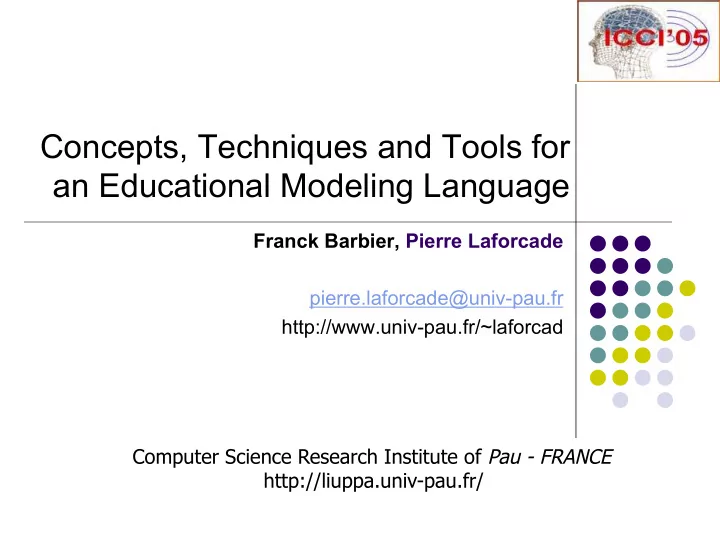

Concepts, Techniques and Tools for an Educational Modeling Language Franck Barbier, Pierre Laforcade pierre.laforcade@univ-pau.fr http://www.univ-pau.fr/~laforcad Computer Science Research Institute of Pau - FRANCE http://liuppa.univ-pau.fr/
Objectives/outline l Presentation of the CPM language l Context, initial objectives, orientations l Existent modeling languages/CPM position l The Semantic Information Model l Experimentation, Use Cases l Dedicated CASE-Tool l Binding facility l Comparison between CPM and the IMS-LD specification l Conclusion/perspectives l Demo 2
Context, initial objectives, orientations l Context (Ph.D.) l Distant learning l Instructional design models l Exploring potential addons of UML (meta)-modeling for the design and implementation of co-operative Problem- Based Learning situations (PBL) l Objective/realization l To propose a graphical modeling language, UML-based , and dedicated to PBL à the CPM language 3
Existent modeling languages/CPM position Design phase Implemen- tation phase IMS-LD EML Natural UML Educational language ontologies Meta-data Analysis Initials Detailed and design requirements design Position of CPM l CPM language à instructional engineers (with pre-requisite to know UML modeling bases) l CPM models à multidisciplinary designers’ team 4
The Semantic Information Model l Syntax (presented at [ICCI,03]) l Abstract (terminology): CPM meta-model l UML-independent l 35 concepts l Concrete (notation): l CPM profile extending UML M3 Stereotypes § MOF Meta-meta-model Tagged values § l Preferred diagrams: conforms to M2 Meta-model CPM UML Class, Use case, § meta-model Activity, States § specializes l Semantics CPM profile conforms to l Natural language M1 l OCL rules CPM models Model M0 Real word, run-time instances 5
Experimentation, Use Cases l Exploring expressiveness thanks to the SMASH case-study Detailed analysis of: Scenario specification: Definition of: • Roles • Roles, resources • Objectives • Resources • Individual activities • Task • Activities • Collaborative activities • Success criteria • Knowledge • Cooperation • Obstacle • … • Event management • Preliminary roles • … • … Model = set of views View = set of diagrams Initial Analysis Design 6 requirements
Experimentation (2): just one example 7
Dedicated CASE-Tool l CPM profile integrated as a module for the Objecteering UML CASE-tool l Customized and adapted HMI l New end-users functions Authoring environment prototype for instructional designers 8
Binding facility l Experimentation of models transformation l Why? l To extend CPM language uses l To provide CPM models with an ODL platform- implementation facility l How? l CPM activity diagrams modeling learning scenarios Stereotypes and tagged values (extension elements from CPM profile) inform and guide transformations l XML models conform to IMS-LD spec 9
Binding facility (2): simple example CPM model IMS-LD model Element information: - Stereotype <<Role>> - Tagged Value RoleKind= learner Element information: - Stereotype <<Activity>> - Nested in a partition of learner 10
Comparison between CPM and IMS-LD CPM IMS-LD Interoperability, reuse, Main goals Communication, abstraction exchange Kind Semi-formal (graphical) Formal Terminology Language CPM meta-model IMS-LD information model Notation UML Profile CPM none Target audience knowing bases of UML trained to IMS-LD Instructional engineer Instructional engineer Concerned steps Detailed design and design Initial requirements, analysis instances Type UML models XML Models Models/ Target audience Multidisciplinary staff in Machine charge of design process Tools One prototype Several prototypes 11
Conclusion l CPM Language l UML-based EML l Dedicated to PBL l Binding facility CPM IMS-LD language language CPM CPM CPM IMS-LD models models models models Initial Detailed Design Analysis requirements design Implementation Deployment Test Evaluation Design phase 12
Positive/negative points of this UML approach for EML ü ü Graphical language ü Models address ü multidisciplinary design team ü ü Upstream IMS-LD û Lack of methodology û ü ü Object-based approach ü UML methods/techniques û UML notation extension is û ü limited /tools could be exploited Explicit modeling of û Instructional engineers’ pre- stereotypes & tagged values û ü ü information thanks to requisite to be “UML-aware” ü Roles of UML Profiles in the û Difficulty to create specific û ü MDA framework tools from scratch 13
Perspectives l CPM point of view: l To make experimentations in cooperation with target- publics l To propose a specific method l To improve models transformation l IMS-LD point-of-view: l Benefits of a UML-profile dedicated to IMS-LD ? l Benefits of a UML-based authoring-tool for IMS-LD ? 14
Demonstration 15
Concepts, Techniques and Tools for an Educational Modeling Language Thank you Q&A pierre.laforcade@univ-pau.fr 16
Recommend
More recommend